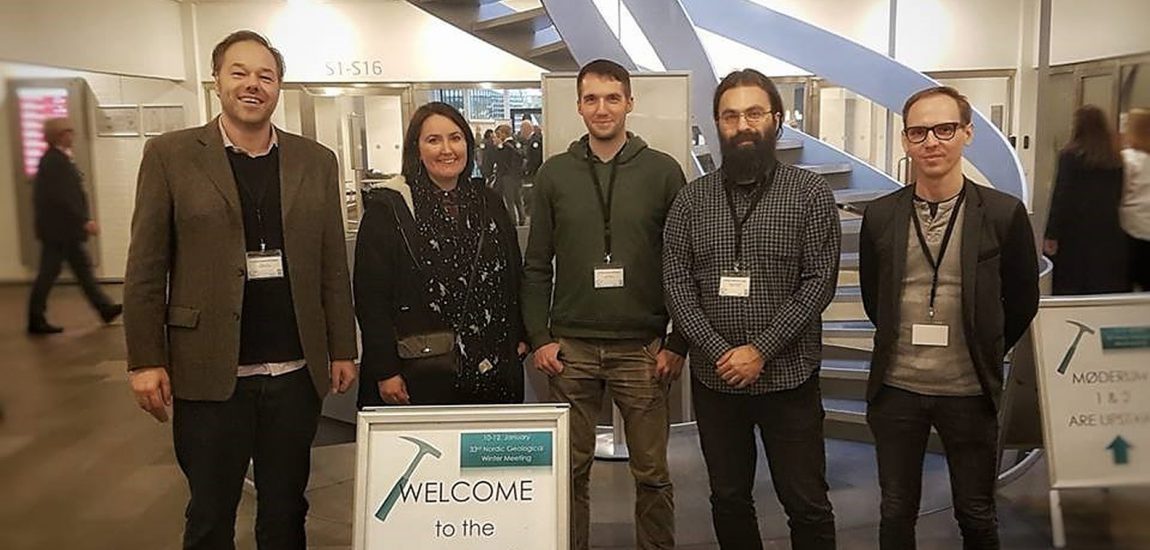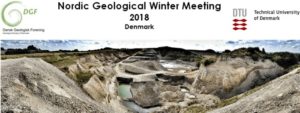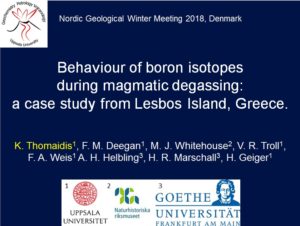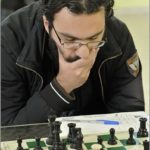
33rd Nordic Geological Winter Meeting

The Nordic Geological Winter Meeting is organised every two years in a different Nordic country (Sweden, Norway, Finland, Denmark, Iceland) and is considered one of the foremost multidisciplinary geological conference in…the Nordic countries! The 33rd Nordic Geological Winter Meeting (Fig. 1) was held at the Technical University of Denmark (DTU), in Copenhagen, Denmark, between the 10th and 12th of January 2018. In this three-day meeting, 17 different topics (igneous rocks and processes, tectonics and structural geology, hydrogeology, etc.) were covered over 52 sessions. More than 600 people attended with 377 oral presentations and 157 poster presentations. The organizers and the student helpers did an excellent job and the meeting ran smoothly.
About the author:
With the support of the European Association of Geochemistry (EAG), through the student sponsorship program, I had the chance to attend and also to present my master thesis research at the meeting. In more detail, the EAG student sponsorship gave me the opportunity to:
(a) attend the igneous rocks and processes theme with its very interesting sessions e.g. micro-beam frontiers in magmatic, metamorphic and hydrothermal systems, geochemistry and modeling of igneous rocks, magmatic plumbing systems, etc;
(b) present my work (master thesis project, Fig. 2) entitled “Behaviour of boron isotopes during magmatic degassing: a case study from Lesbos Island, Greece”. In this project my co-authors and I are trying to decipher the fractionation behaviour of boron isotopes during magmatic degassing in a well constrained natural test case. We employed SIMS analyses in a pristine boron-rich rhyolitic glass that we showed to be homogeneous at the 2σ level indicating only minor fractionation in the pre-eruptive melt during degassing at magmatic temperatures. This finding suggests that volcanic glass may be a reliable tool for investigation of subduction fluids in arcs.
(c) Upgrade my presentation skills by acquiring important oral presentation experience at an international scientific conference.
(d) Obtain valuable feedback for my work from experienced scientists from the field of igneous geochemistry.
(e) Make academic contacts and search for an upcoming academic career (PhD).
Overall, it was a great and valued experience for an early career scientist so, I am very grateful to the EAG (Fig. 3).
Noteworthy talks of the meeting included the plenary talk by Sune Nielsen about stable isotopes in subduction zones and also the keynote talks of Dan Condon (the EARTHTIME initiative: a community working to accelerate the development and application of integrated methodologies for the quantification of geological time), David Chew (U-Pb calcite and zircon dating by LA-ICP-MS image mapping) and Thor Thordarson (melt inclusion studies on basaltic magmas in Iceland).
However, at the 33rd Nordic Geological Winter Meeting I was not alone! The Geochemistry, Petrology and Volcanology research team at Uppsala University also participated as conveners in sessions and also with four oral presentations. The team consists of (Fig. 4, from left to right) Prof. Valentin Troll, Dr. Frances Deegan, Dr. Franz Weis, master student Konstantinos Thomaidis and doctoral student Geiger Harri.
I hope EAG will keep the student sponsorship program but also try to expand it in the future as the benefits can be really crucial for an early career scientist like myself.

About the author

Konstantinos Thomaidis is a geology master student (specialization in geochemistry) at Uppsala University in the Department of Earth Sciences and also a research assistant of the Geochemistry, Petrology and Volcanology research team. He holds a BSc degree in geology from Aristotle University of Thessaloniki. He is currently working with SIMS analysis of boron isotopes during magmatic degasing in a natural case and also with xenopumice from Mt. Etna’s 2013 eruption. When he is not dealing with science he is playing chess.
